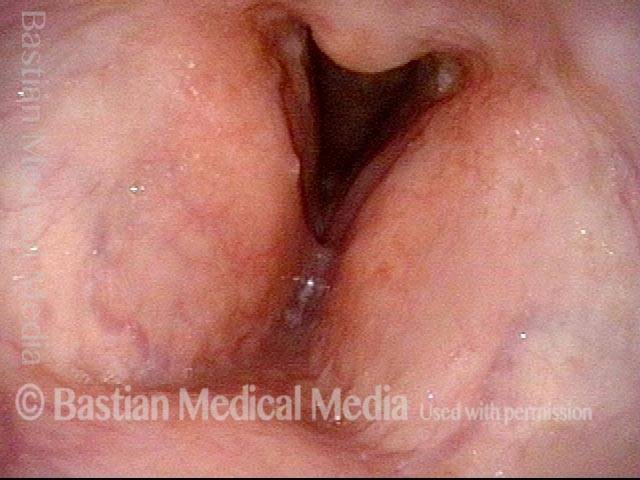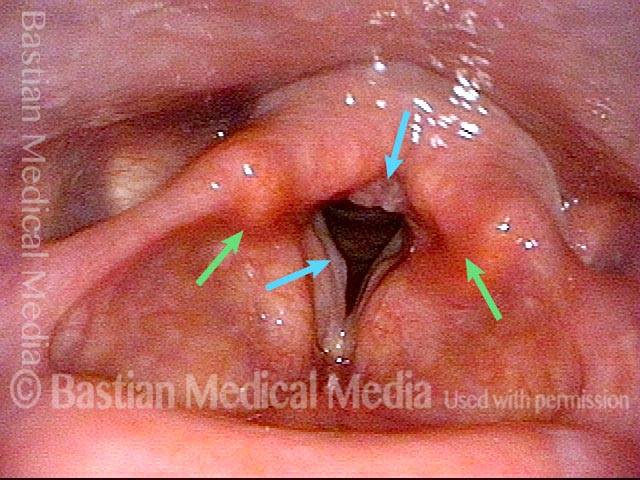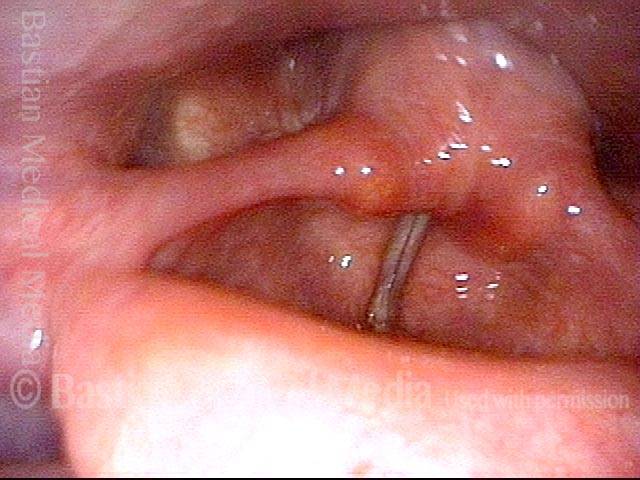Pachyderma
Pachyderma literally means “elephant skin.” Used in laryngology to refer to rough or thick mucosa. Most often seen in the interarytenoid area and is thought to be indicative of acid reflux or, sometimes, chronic bacterial infection. It does not typically affect the voice, though the underlying cause of the pachyderma can (e.g., chronic inflammation from acid reflux or chronic bacterial laryngitis). In such a case, the true vocal cords themselves appear intensely red.
Pachyderma, caused by Laryngitis Sicca
Heaped up Mucosa (1 of 3)
Pachyderma, here referring to the heaped up mucosa in the interarytenoid area, in a patient with laryngitis sicca.
Heaped up Mucosa (1 of 3)
Pachyderma, here referring to the heaped up mucosa in the interarytenoid area, in a patient with laryngitis sicca.
Pachyderma (2 of 3)
Adducted (voicing) position. Note that the pachyderma does not interfere with closure of the cords. In this case, it does not directly affect the patient’s voice, which is typical, but the more generalized inflammatory condition (see the redness of the cords) does.
Pachyderma (2 of 3)
Adducted (voicing) position. Note that the pachyderma does not interfere with closure of the cords. In this case, it does not directly affect the patient’s voice, which is typical, but the more generalized inflammatory condition (see the redness of the cords) does.
Stippled Vascular Markings (3 of 3)
Narrow-band lighting. This shows some stippled vascular markings, often seen with chronic inflammation or HPV infection.
Stippled Vascular Markings (3 of 3)
Narrow-band lighting. This shows some stippled vascular markings, often seen with chronic inflammation or HPV infection.
Acid Reflux Laryngitis
Acid reflux laryngitis (1 of 2)
Panoramic view, shows interarytenoid pachyderma (“elephant skin”) at upper blue arrow; arytenoid redness at green arrows; and mucus retention cyst at lower blue arrow.
Acid reflux laryngitis (1 of 2)
Panoramic view, shows interarytenoid pachyderma (“elephant skin”) at upper blue arrow; arytenoid redness at green arrows; and mucus retention cyst at lower blue arrow.
Acid reflux laryngitis (2 of 2)
During phonation, interarytenoid pachyderma and mucus retention cyst are typically obscured.
Acid reflux laryngitis (2 of 2)
During phonation, interarytenoid pachyderma and mucus retention cyst are typically obscured.
Share this article





